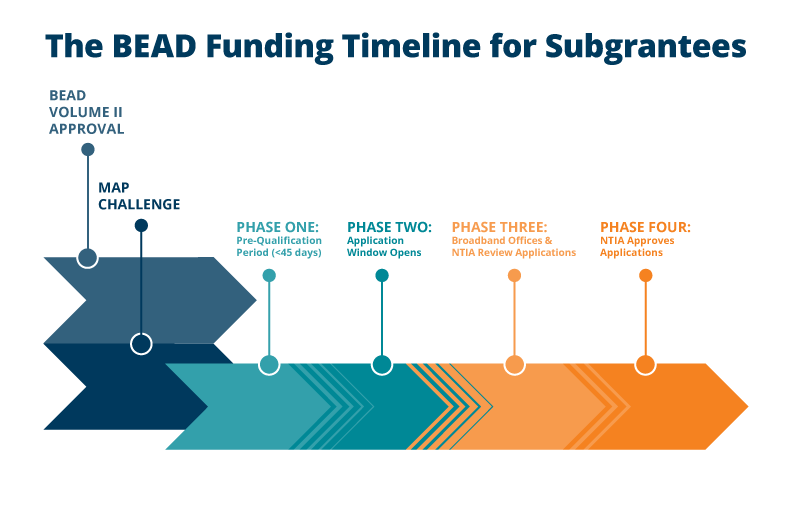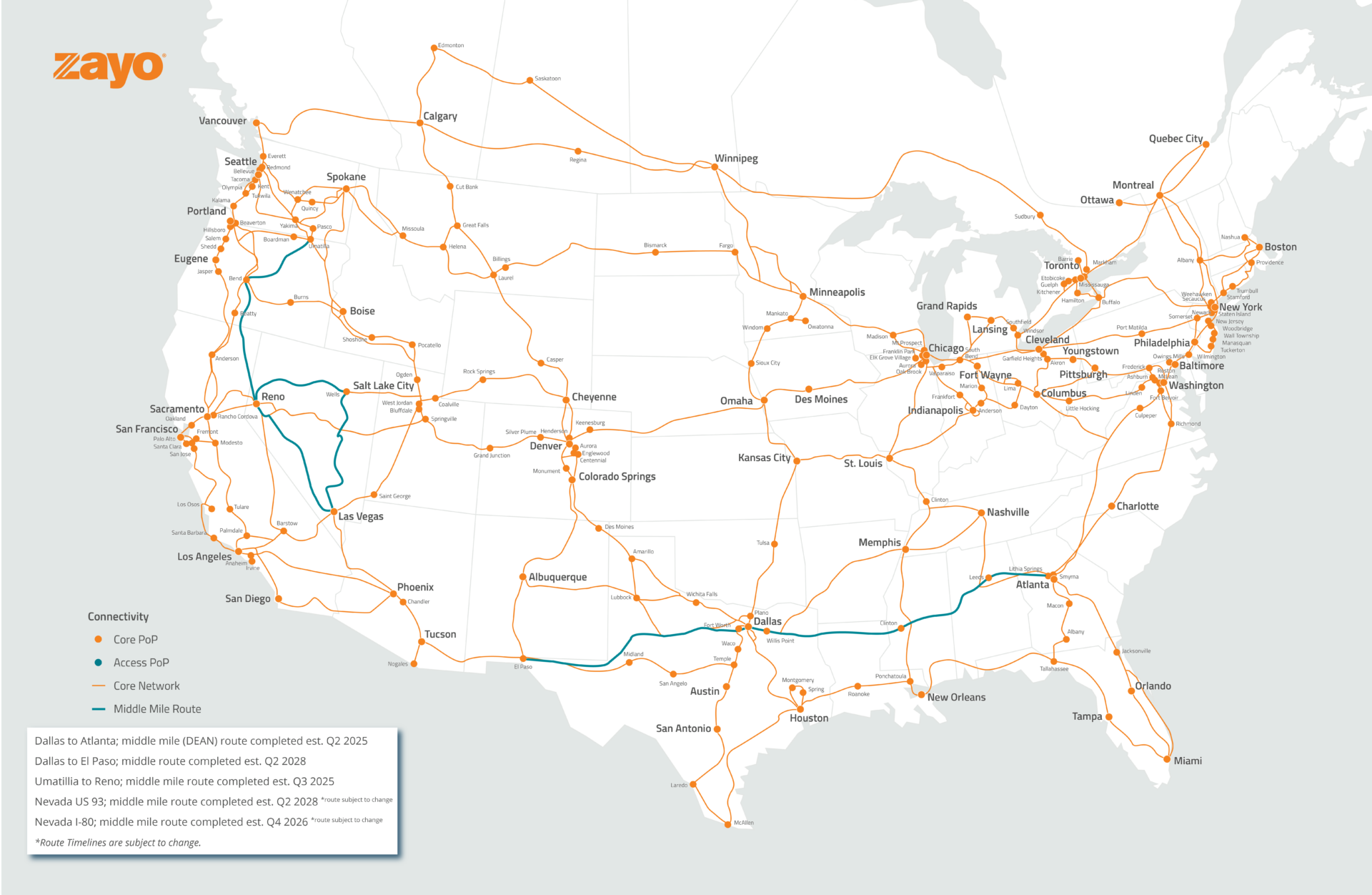Approximately 42 million Americans lack access to reliable, high-speed broadband services today, including 39% of rural Americans.
The federal Broadband Equity, Access, and Deployment (BEAD) Program aims to bridge digital gaps by providing $42.45 billion to expand high-speed Internet access in underserved and unserved locations across the U.S. and its territories. The program funds planning, infrastructure, deployment, and adoption programs. Eligible applicants who wish to fund infrastructure projects with BEAD can soon begin applying for this funding, which has already been distributed to states and territories.
Internet service providers (ISPs), especially those serving rural, underserved and unserved communities, should take advantage of this opportunity to fund critical last-mile projects in in-need locations. This funding can help mitigate cost-related constraints for last-mile fiber builds in rural areas.
However, many ISPs don’t have the resources in-house to take advantage of this funding. Plus, there’s a lot of competition out there, among other smaller ISPs and with larger ISPs who may have the resources to pursue this funding more effectively.
Luckily, Zayo is here to help ISPs without the proper resources on hand effectively navigate the BEAD funding process. We can provide BEAD funding application support and help ISPs more cost-effectively and easily build infrastructure to reach underserved and unserved communities. This guide will walk you through the BEAD funding process step by step and share exactly how Zayo can help.
Who Can Apply for BEAD Funding?
In June 2023, the National Telecommunications and Information Administration (NTIA) released its plans for allocating $42.45 billion in funding to every U.S. state and territory.
Now, it’s time for the states and territories to determine how the NTIA should distribute this funding to eligible applicants, or “subgrantees” of the BEAD program including:
- Institutions of higher learning
- Nonprofit organizations
- Cooperatives
- Public or private utilities
- Public utility districts
- Public-private partnerships
- Private companies
- Local governments
- Tribal organizations
- For-profit organizations
In addition to belonging to one of the groups listed above, subgrantee applicants must have:
- The ability to carry out a project in a competent manner compliant with all applicable federal and local laws
- The financial and managerial capacity to meet commitments of the grant
- The technical and operational capability to meet the commitments of the grant
What Do Subgrantees Need to Demonstrate When Applying for BEAD Funding?
The first step once you have determined that your organization is eligible for funding is to pull together the proper documentation and certifications that tell your state or territory’s broadband office that you have the resources in place to successfully complete your project using BEAD funding.
You will likely need to demonstrate the following with the appropriate documentation:
- Financial Capacity: Prospective subgrantees must provide an irrevocable standby letter of credit (LOC) compliance statement to the state or territory they are applying for funding in. The LOC helps the subrecipients allocate the funding and determine that the company asking for funding can support the network build financially. The LOC must be at least 25% of the subaward amount and obtained from a U.S. bank with a Weiss safety rating of B- or better. Subgrantees may also need to maintain an LOC or performance bond for 10% of the subaward until they’ve completed 100% of the project’s locations or the subaward’s period of performance ends. Zayo can provide access to our financing ecosystem and proportionally execute LOC based on the proportion of grant funding allocated to the middle mile.
- Organizational Capacity: Applicants must ensure that they have the team and people resources in place to successfully carry out the BEAD-funded project.
- Technical Capacity: Demonstrate to the broadband offices that you and your vendors have the workforce skills on hand to carry out the project.
In addition, subgrantees must provide information demonstrating:
- Adherence to Federal Labor and Employment Laws
- Cybersecurity Supply Chain Risk Management Compliance
- Company Ownership and Control
- Adherence to National Laws
How Do I Apply for BEAD Funding?
It’s important to note here that the BEAD funding process differs by location. Namely, when each phase starts, scoring criteria, and which department or government agency your broadband office exists under will differ depending on your state or territory. However, there are more similarities than differences between the states and territories in this process. In this section, we’ll speak more broadly about the BEAD funding process and will offer some location-specific insight below.
In general, subgrantees apply for BEAD funding through state broadband offices within a department or other existing government agency. In some states and territories, this broadband office will exist within the Department of Transportation, in others, the Department of Commerce or Governor’s office. Regardless of where this office sits, you’ll want to keep a close eye on your state or territory’s broadband office for the location-specific BEAD funding timeline and where to submit your application.
BEAD Funding Timeline
At this point, most states and territories are in the pre-qualification period. For this blog, we will walk through the BEAD funding timeline beginning with funding distribution.
Although the dates will be different by state, every state has to follow the same steps, outlined below:

BEAD Volume II Approval
Once state applications are approved by the NTIA, state and territory broadband offices have one year to allocate funding to applicants selected for awards. Some are still awaiting volume II approval. Still, prospective subgrantees awaiting volume II approval should prepare for the following steps, which will happen soon after BEAD volume II is approved.
Map Challenge Process
The first upcoming step is the map challenge process. This is when incumbent carriers challenge individual unserved and underserved locations eligible for BEAD funding. ISPs self-report on existing broadband capabilities by location during this step, and broadband offices will determine based on these capabilities if a location needs funding from the BEAD program.
Phase One: Pre-Application Intake Process
Depending on the location, this process can take up to 45 days.
Phase one includes the public comment period when the project area map and grant guidelines are shared. During this phase, the final project area map and grant guidelines will be published on your state or territory’s broadband office’s website. BEAD applicants will submit initial application details during this phase including everything listed under “What Do Subgrantees Need to Demonstrate When Applying for BEAD Funding?” above.
Phase Two: Application Window Opens
During phase two, the application portal will open. Application summaries and project areas are posted to the broadband office websites during this period. This is when subgrantees apply to receive BEAD funding. BEAD funding applications are scored using pre-determined criteria that differ slightly by location, outlined in greater detail below.
Phase Three: Application Review Process
This is when broadband offices review the applications submitted to them by subgrantees and decide who should receive funding. The broadband office then makes a recommendation to the NTIA for which subgrantees should receive funding, and the NTIA reviews the recommendations to make decisions for allocating the funding. It’s difficult to determine with certainty at this point how long this process will take after applications are received.
Phase Four: Post-Application Review
Once applications are reviewed, subgrantees can expect broadband offices to get back to them with BEAD funding decisions in around 30 days.
How Are BEAD Funding Applications Scored?
During the application phase all eligible locations based on the map challenge process will be available for application.
Round one of the application phase will include all eligible locations and subsequent rounds will include eligible areas without awarded applications. The primary focus is on fiber builds, then non-fiber solutions. The locations of focus in future rounds will typically require non-fiber or alternative technology like fixed wireless access (FWA) and satellite linking to high-cost, super rural areas that are not economically feasible to reach with fiber.
So, how do the broadband offices determine who gets allocated funding?
Broadband offices will use primary and secondary scoring criteria to determine which organizations or subgrantees are selected to receive funding. Applicants should aim to maximize their score based on this criteria.
Primary criteria are generally worth 75% of your total score and include the following:
Minimal BEAD Outlay
This refers to the efficiency with which BEAD applicants will use allocated funds, and is worth the most amount of points – anywhere from 40-65% of total points. Broadband offices want to know that your organization can fund your project without relying too heavily on BEAD funding support.
The higher the percentage of BEAD broadband funding you require to complete your project, the fewer points you’ll score. On the other hand, if you are funding a $10 million project, for example, and require only 10% of your funding to come from BEAD, you’ll likely score the maximum amount of points.
Zayo has connections with third-party funding sources and can help smaller ISPs secure the necessary funding to lower the percentage of project funding the BEAD program would need to provide. Our scale and backing by the largest infrastructure funds makes us a valuable partner for smaller organizations. Zayo can also support smaller ISPs with our middle-mile networks, which make it more cost-effective for ISPs to build out into underserved and unserved areas.
Affordability
Worth somewhere between 15-40% of points in most locations, points for affordability are determined by ISPs’ ability to demonstrate that they can provide both middle-class and low-cost affordability tiers. Subgrantee applicants must show that they’re committed to providing the most affordable price for the customer for priority broadband projects.
Subgrantees must provide the total price for customers receiving speeds of 100/20 Mbps – the Federal Communication Commission (FCC)’s latest fixed speed benchmark for broadband download and upload speeds. All BEAD recipients must demonstrate low-cost service plans that target eligible, low-income households. Some broadband offices will allocate points based on low-cost options.
Zayo can help increase ISPs’ ability to score the highest number of points for affordability by reducing backhaul and middle-mile construction costs, enabling ISPs to pass off cost savings to customers.
Fair Labor Practices
Finally, broadband offices want to see that subgrantees’ labor and employment standards follow the law. This criterion is worth 10-15% of the total points in most locations.
In addition, subrecipients may require subgrantees to list further fair labor standards including demonstrating their workforce is properly skilled and credentialed, detailing local hiring efforts, complying with wage standards, and committing to union neutrality. Applicants may also have to demonstrate commitment to recruiting a diverse workforce, ensuring workforce union status, and using apprenticeships to ensure a qualified workforce.
Zayo has a strong track record of working with reliable construction vendors. We also work with trained employees with experience handling similar projects.
Secondary criteria account for the remaining 25% of points and it’s up to each state or territory how they allocate these points. However, it may include the following:
Speed to Deployment
No matter what state or territory you’re receiving funds from, you must finish all BEAD-funded deployments within four years of receiving grant funds. You must demonstrate the ability to complete your project in this timeline in your application.
By working with Zayo, ISPs can speed up project timelines by leveraging Zayo middle-mile networks. By tapping into existing or in-progress middle-mile infrastructure, ISPs can reduce the amount of last-mile fiber they need to build, lowering costs and reducing time to deployment.
Speed of Network and Other Technical Capabilities
It’s important to know whether your state or territory puts a lot of emphasis on the speed of the network or very little. Broadband offices may put less emphasis on high-speed offerings if they put more weight on low-cost options, and vice versa. Zayo can help ISPs increase the speed and reliability of their network by providing reliable, high-speed middle-mile connectivity.
Open Access
Open access networks host a variety of ISPs on a single fiber network. Zayo offers open-access networks that provide fair pricing and don’t differentiate between national and local providers. As a “carrier’s carrier,” Zayo provides the underlying infrastructure needed to support last-mile projects without bias.
Local and Tribal Coordination
Subgrantee applicants in locations with large tribal presences and/or with projects that cross into tribal land will need to demonstrate local coordination and tribal outreach by providing letters of support from tribal or local leaders with their applications.
Zayo has state and local account teams there to support ISPs as they navigate tribal and local coordination. We have experience working at the local level across the U.S. to ensure support for fiber builds.
Equitable Workforce Development and Job Quality
Some ways to demonstrate equitable workforce development and job quality may include plans to promote diverse hiring practices, prioritize hiring local workers, and offer equitable job opportunities for historically underrepresented groups.
In some locations, providing these opportunities is a law. Zayo works with local partners and government groups to ensure equitable workforce practices.
Community Impact
Letters of support from anchor institutions like schools and hospitals demonstrate the need for broadband services in the community and convey confidence in your company’s ability to provide the services needed to support them.
Zayo has a large customer base of community anchor institutions that can help instill confidence in Zayo’s ability to provide the services needed to positively impact the community.
BEAD Funding by Location
As mentioned previously, funding timelines differ by state or territory. With the largest independently-owned network in North America, experience navigating government funding, and the resources to support smaller ISPs through the application process, Zayo is positioned to help ISPs in their BEAD funding journey across most states in the continental U.S.
However, we are currently leveraging over $300 million in government funding grants to build our Digital Equity Access Network (DEAN) architecture across Zayo’s government-funded projects which will make it even easier and more cost-effective for ISPs to build out critical last-mile infrastructure. DEAN provides flexible interconnection points in our middle-mile network and Zayo can help with equipment installations along these routes.
The map below details where DEAN will be available when and where Zayo’s fiber exists today.

DEAN architecture will be available soon in five states in particular, where Zayo is uniquely positioned to help ISPs navigate the BEAD funding process. We plan to continue to expand this architecture as time goes on.
How Zayo Can Support BEAD Funding Projects in Texas
Texas is home to over two million Zayo fiber miles. Two of our NTIA-funded middle-mile infrastructure projects – one route from Dallas to Atlanta, and another from El Paso to Dallas – are helping to connect underserved and unserved communities in Texas and nearby states across 644 route miles.
In addition, Zayo was awarded $27.8 million in American Rescue Plan Act (ARPA) funding from Dallas County to construct and upgrade critical middle-mile infrastructure and bridge digital equity gaps.
How Zayo Can Support BEAD Funding Projects in California
Zayo has built over 1.4 million fiber miles in California. One of our NTIA-funded middle-mile routes built with our DEAN architecture, spans more than 420 route miles from Umatilla, Oregon to Reno, Nevada, connecting rural communities in Northern California including Alturas, Spanish Springs, and Herlong.
How Zayo Can Support BEAD Funding Projects in Utah
Zayo’s network in Utah spans nearly 300,000 fiber miles. Robust Zayo network infrastructure connects across the state including diverse routes spanning I-70 and I-80, connecting into Salt Lake City then from Salt Lake City to Reno, connecting to our middle-mile infrastructure there.
How Zayo Can Support BEAD Funding Projects in Oregon
Oregon hosts over 530,000 miles of Zayo fiber. Our NTIA-funded route connecting from Umatilla, Oregon to Reno, Nevada also connects rural, underserved and unserved communities in Oregon.
How Zayo Can Support BEAD Funding Projects in Nevada
One of Zayo’s NTIA-funded, middle-mile routes built with our DEAN architecture connects from Umatilla, Oregon to Reno, Nevada, connecting Panther Valley and Reno area rural communities.
In addition to the cross-state NTIA-funded route, Zayo has received $29 million in funding in Clark County, Nevada via the American Rescue Plan Act (ARPA) and $152 million funded by the NTIA and State Treasury Funds via the State of Nevada.
Zayo is Here to Help ISPs Navigate BEAD
Overall, the BEAD funding process can be difficult to navigate, especially if you don’t have dedicated resources on your team to do so.
Zayo is here to be that trusted partner, filling in resource gaps you may have as you navigate the BEAD funding process. We provide expert support to subgrantees from the pre-application phase onward.
In addition to an extensive, independently owned and operated fiber network, Zayo is experienced in securing and implementing grant funding, securing a total of over $300 million in funding to date. With over 860 carrier relationships globally, we ensure flexibility and fairness. Additionally, we partner with leading manufacturers like Ciena to ensure robust and reliable network solutions.
Zayo is uniquely positioned to provide support for ISPs through Zayo’s Broadband Infrastructure Deployment Alliance (zBIDA). Our zBIDA program offers comprehensive support to ISPs, enabling them to access and use federal and state funds for last-mile project execution.
Zayo supports our zBIDA partners from day zero, helping you create compelling network narratives, align with national strategic partners, plan and budget costs, and navigate government regulations. Once you’ve been awarded your grant, you can more easily and cost-effectively build the last mile using Zayo’s middle-mile network. With our partnership, you will gain access to a carrier-neutral, open-access network that leverages our DEAN architecture.
This communication was prepared by Zayo Group using funds under awards 08-40-MM228, 08-40-MM216, 08-40-MM217, and 23-40-MM339 from the National Telecommunications and Information Administration (NTIA), U.S. Department of Commerce (DOC). The statements, findings, conclusions, and recommendations are those of the author(s) and do not necessarily reflect the views of the NTIA or DOC.


